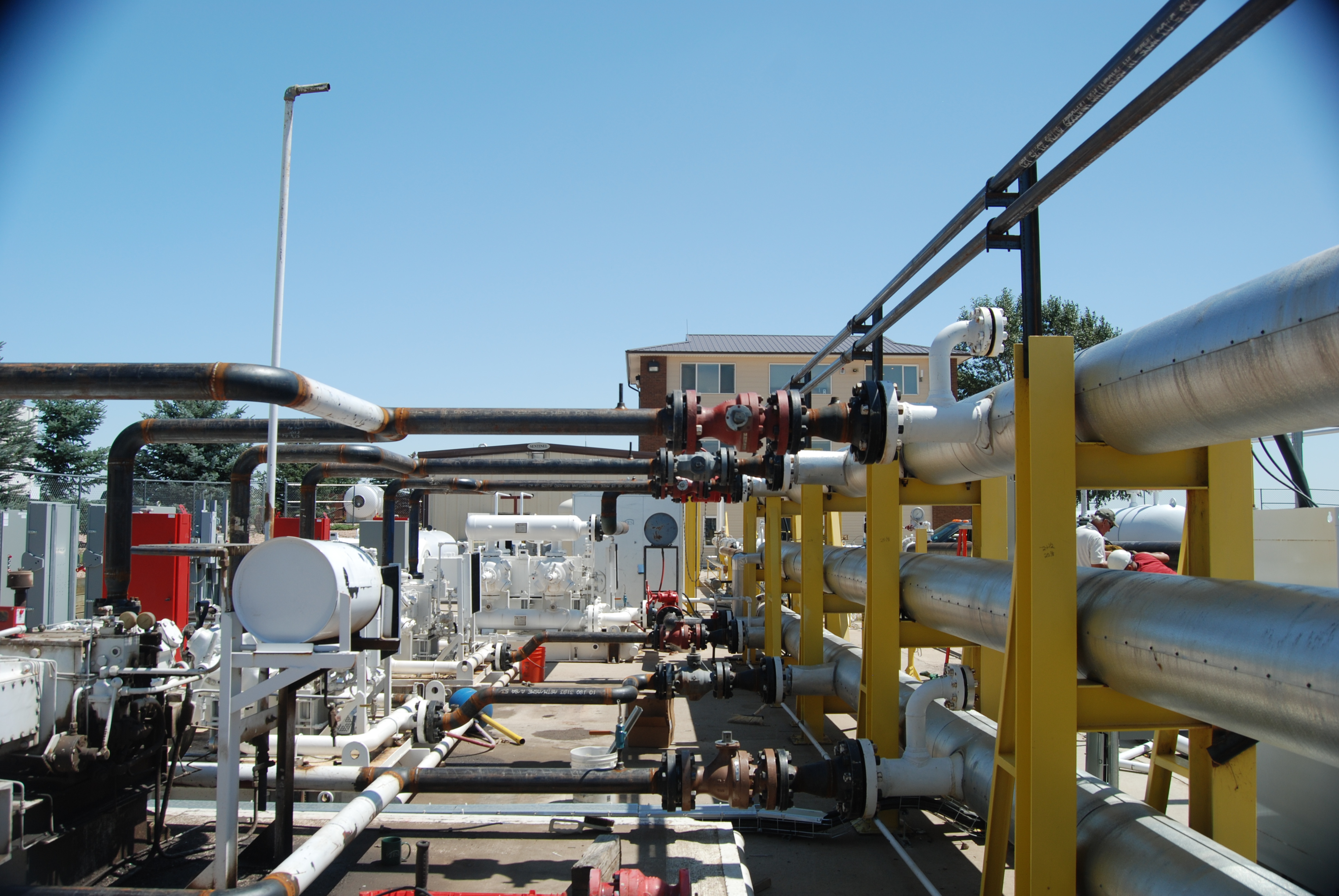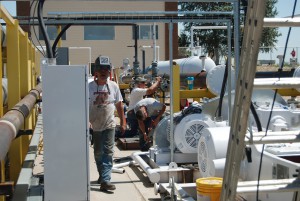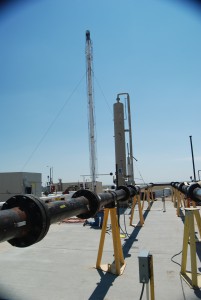September 2011, Vol. 238 No. 9
Features
To Calibrate Or To RecalibrateThat Is The Question

COLORADO SPRINGS, CO–Measurement may not be the most glamorous aspect of the natural gas business, but it sure is one of the most important from a dollars and cents perspective.
In the United States, Colorado Engineering Experiment Station, Inc. – CEESI – has been a leader in high-quality flow meter measurement for more than 40 years.
CEESI is actually two research centers. The main site in Nunn, CO includes responsibility for advanced flow measurement technology and calibration services. Its Iowa Natural Gas Facility (CEESIowa) is in Clear Lake on a custody transfer location owned by Northern Border Pipeline Co. The facility flows 2.4 Bcf/d. The natural gas used for meter calibrations is first diverted from the pipeline and then returned after calibrations are completed. It is the only facility in the U.S. that can calibrate ultrasonic meters larger than 10 inches in diameter.
CEESI’s activities are highly regarded by measurement specialists in the industry, nearly 200 of whom participated in a recent weeklong ultrasonic user’s workshop in Colorado Springs.

From Rockets To Pipelines
The organization was originally started in 1951 as the “Engineering Experiment Station” at the University of Colorado where its focus was on small rocket development and research, eventually branching out to testing turbine meters for the US Navy. In 1966, its founder, Professor Tom Arnberg, moved the facility to a Atlas E Missile Silo on the Pawnee Grasslands of northern Colorado and is still home to an unknown number of jackrabbits.
Current president and CEO Steve Caldwell has spent his entire adult life at CEESI, beginning work there during the summer of 1965 while still in high school. In an interview during the CEESI workshop, Caldwell, a tall, angular fellow with a beard that seems well-suited for Colorado, matches a wry sense of humor with an avuncular mien, gives the impression of being a flow measurement guru. That’s ironic since he actually earned his bachelor’s degree in science rather that metrics at the University of Northern Colorado in Greeley.
After the center was moved to the prairies of northern Colorado, it was renamed CEESI and operated as a non-profit research and testing facility until 1986 when it lost its non-profit status. To keep CEESI afloat, Caldwell and a longtime business partner, Walt Seidl, bought the facility from the government and reopened it as a corporate entity that would specialize in commercial tests.
“Walt and I went on the hook for a lot of money like most small businesspeople do. We had to make payrolls, mortgages, etc., but we made it work because we both felt it was a good business,” Caldwell said. Seidl, a trained flow measure specialist, retired in 2010 after 35 years with CEESI, including serving as president from 1976-2008.
Caldwell recalled that most of CEESI’s early work involved calibrating aerospace instruments and helping the automotive industry develop new carburetion methods and flow meters for vehicles. As the business began to grow CEESI eventually began doing research on new types of flow meters for the natural gas distribution and transmission industry. From just two employees in the ’60s, CEESI’s staff today exceeds 50.
Meanwhile, major strides were being taken in the natural gas business to free up the commodity. Energy companies needed to improve their measurement uncertainties just as CEESI’s other clients had to, so a cross-correlation of services soon evolved and grew rapidly.

“That’s when we really hit the energy industry big since it appeared to be our largest revenue base which is why we started in the energy industry. They could see the need to have lab capacity to develop and calibrate larger flow meters and just do research in a more realistic manner,” Caldwell said.
To help the industry in flow meter testing of unprocessed natural gas CEESI constructed its Wet Gas Test Facility in 1998. CEESIowa opened the following year because most of the large-diameter meters were being sent to Europe for calibration.
While the energy industry now comprises about 65% of CEESI’s business – the balance being automotive, aerospace, military and nuclear clients – it serves as an excellent example of how investment in research actually reaches across many types of industries.
Two years ago CEESI was converted into an ESOP (Employee Stock Ownership Plan) that is controlled by a parent holding company called WEST (Western Energy Support Technology). Earlier this year, CEESI merged with CPL & Associates to form CEESI Measurement Solutions Inc. (CMSI) to provide auditing, engineering, and consulting services to the industry. Both CMSI and CEESIowa fall under the WEST umbrella. CEESI’s next expansion is expected to be a multi-viscosity oil and calibration facility at a still undecided location, Caldwell said.
The CEESI Mission
Caldwell said CEESI has never lost sight of its overall mission – constantly improving the state of the art of measurement for the energy industry.
“The goal of the company is to provide the best measurement for custody transfer that we can attain,” he said. “It’s important to us to be able to provide quality services because millions of dollars of products pass through a meter station –and without proper measurement it could result in losses of tens of millions in a year. We’ve done that through improvements in our primary standards by cooperating with National Institute of Standards and Technology (NIST) and by comparing ourselves with other flow labs around the world.”
Today, CEESI is capable of testing a wide range of types of flow meters including turbine, vortex, differential-pressure, Coriolis, magnetic, positive-displacement, cone meter, ultrasonic, as well as a variety of valve types. It offers flow meter calibrations accredited by the National Voluntary Laboratory Accreditation Program, ISO 9001, and ISO/IEC 17025 for specific meter types, fluid types, and line sizes at the Colorado and Iowa facilities. Calibrations are in accordance with NIST quality-control procedures.
The World Of Research
To succeed in the competitive realm of energy research for the limited number of available dollars, Caldwell credits CEESI’s ability to provide an extensive research program.
“We really have very few limits on what flow rate, or capacity, we can provide to the industry. Therefore we don’t have the limitations that some other labs have. We have an engineering staff that has hundreds of years of experience between them and when we obtain a research project we put our resources together – both the capabilities of our lab and our technical know-how from our engineering staff. We think that’s fairly unique,” he said.
For years most of the research for natural gas pipelines was funded by the Gas Research Institute (GRI) through a small surcharge collected by the Federal Energy Regulatory Commission (FERC). Those funds slowly dried up and GRI became Gas Technology Institute where pipeline research was no longer a core focus. Today most of the research is funded mainly through the Pipeline Research Council International (PRCI) where most of the focus is on safety-related issues instead of flow measurement.
Despite the lack of research dollars and the extended economic downturn, Caldwell said there has been little effect on CEESI’s general calibration business which provides 90% of CEESI’s annual revenue. The balance comes from training and consulting services.
“We’ve had two of our best years ever in the last three years. I think companies took advantage of the fact that they could get caught up on some of their maintenance and on some of their measurement projects, so we became very busy,” he said.
Customers appreciate CEESI’s well-established integrity and the value they get for their dollar although it is not cheap to calibrate a meter.
Testing becomes increasingly expensive as the level of uncertainty continues to decline. When they began at CEESIowa the original uncertainty was 0.35%; it is now down to 0.23% and they are working on a cooperative research agreement with NIST to drop that to 0.15%. Not only will this improve high flow measurement, but it will also help better determine gas composition.
What CEESI does not get in PRCI funding it typically co-funds with either money, facilities, or engineering time with individual vendors and operating companies.
The Need For Calibration
CEESI calibrates between 3,500-4,000 meters annually, many on the gas transmission side, with its larger meter sets. When Caldwell and his staff talk to transmission operators, one major concern they inevitably hear about is the cost of calibration or recalibration.
“The users see there is a need to recalibrate meters – we’ve calibrated thousands of ultrasonic meters that are now starting to come back for recalibration,” Caldwell explained.
That concern has grown since ultrasonics became the meter of choice for transmission measurement. So users are trying to figure out if they can use the diagnostics inside those meters to help them determine whether they need to be recalibrated. That’s what they would prefer to do but until they become comfortable with that self-diagnostic concept they are going to have to continue adding the expense of recalibration to their O&M budgets.
What happens in the life of an ultrasonic meter is that after it is manufactured, it undergoes a process of dry calibration to ensure that the sound speeds and ultrasonic paths are in order. Since they still do not know the base level of that meter it is sent in for initial calibration. At the CEESI lab the appropriate correction factors are programmed into the meter that minimize measurement error.
In its lab, CEESI takes a “fingerprint” of the meter’s performance as it is being calibrated. The meter is removed from the facility and installed on a transmission line. Technicians watch the meter’s fingerprint as it is started up and brought online at the metering station. If those fingerprints are comparable it means the flow conditions are good, the meter is working properly and can be placed into operation. Then everyone can begin trading dollars across that meter.
After the meter is online for a period of time, technicians will periodically check the diagnostics. If they observe something is wrong, the meter is removed from service and sent in for recalibration. In the U.S. – unlike Europe and Canada – there is no legal metrology used to determine how long after calibration that a meter should be recalibrated.
But operators are savvy enough to realize how their bottom lines can be affected by faulty measurement and they are not lax in sending them back to the lab for a closer look, especially if they want to get that meter back as soon as possible. It’s crucial to schedule service in a timely manner as manufacturers typically schedule meters for calibration two to three months in advance. If a user sends the meter to the lab on time it can be turned around in a few days. Otherwise it can take four to six weeks because of the backlog.
Caldwell does not foresee development of a national standard in the U.S. for calibration.
“Calibration is by agreement and contract and that program has worked well,” he said. “After all, you don’t have to calibrate meters. You can just take it out of the box and if you and the customer agree that you’re going to trade dollars over this meter then it doesn’t have to be calibrated. However, the value of the product that goes through the meter is so great that one or the other is going to win because that meter is not calibrated.”
Ultrasonics Still The Rage
With so much attention being paid to ultrasonic meters, has it actually lived up to the hype? Caldwell believes it has.
“The problem with ultrasonic technology is that I think it’s capable of better measurement than the lab can provide because the science and engineering behind it is solid. It’s really good physics. I believe that it’s up to us – the calibration provider – to lower our uncertainties to meet what the meter is capable of,” he said.
The transmission industry is migrating away from large-diameter orifices into ultrasonic metering, especially on new installations, he said.
“We’re not seeing that much growth in the use of turbine meters like we used to. There are still a lot of turbine meters in use but not nearly the number there used to be.”
“I see improvement in ultrasonic metering mainly due to there being more players coming into the market now and providing gas meters. I think that’s going to drive improvement in the product.
The boom from the nation’s many shale plays also offers increased opportunities for the measurement side of the business. Some of the unprocessed gas has already made its way into CEESI’s Wet Gas Research Facility for additional study.
“Obviously if you’re going to produce it there’s a need to measure it, so there is going to be a demand for more measurement locations. They may not all be ultrasonic measurement; there could be a lot of orifice installations going into the lower-volume lines. Those gathering systems that come out of those shale plays will eventually feed into transmission systems and that’s going to require measurement,” he said.
Manpower Challenges
Looking ahead Caldwell sees several challenges for the measurement side of the business – the lack of research dollars he mentioned earlier and the lack of qualified personnel.
“I am concerned mainly that measurement seems to be given low billing when it comes to company resources. Twenty years ago gas companies had a full-blown measurement department with trained staff. Now you have a couple of people who are in charge of thousands of miles of pipelines and measurement on those pipelines,” he said.
“There’s no longer much emphasis at the university level on flow measurement so I’m not sure if young engineers or technicians are really exposed to measurement right now. I also see a need for smarter technicians and enhanced training from providers like us and others.”





Comments